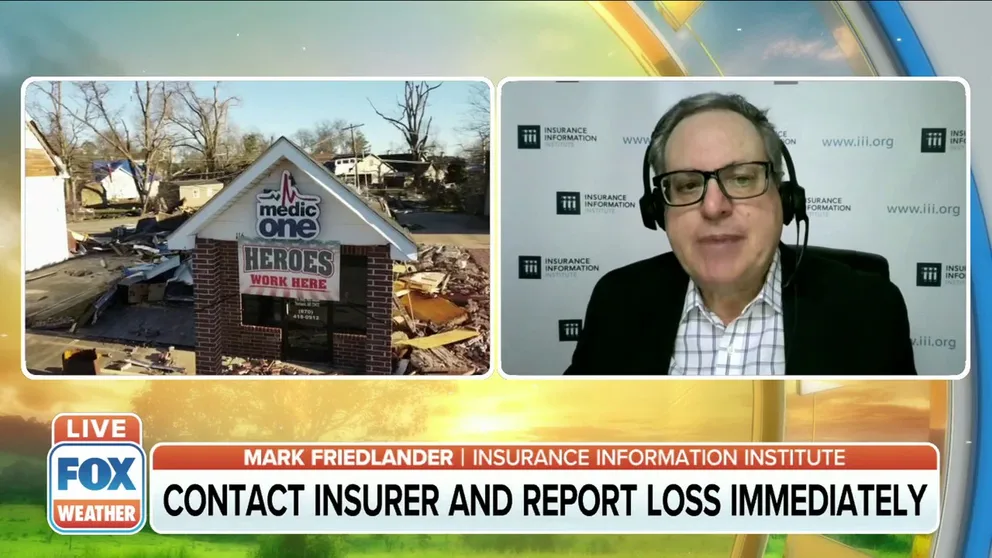What you should do if your property sustained tornado damage
Documentation, receipts some of the most important things when it comes to storm damage insurance claims
Insurance implications for residents impacted by tornado outbreak
The Insurance Information Institute discusses the insurance implications for residents and business owners impacted by the devastating tornado outbreak this past weekend.
Tornadoes can cause damage wherever they touch down. Sometimes it’s a felled tree or roof damage. Other times entire towns are leveled.
According to the National Oceanic and Atmospheric Administration, there are about 1,000 tornadoes reported in the U.S. each year.
Since 1980, severe storms have caused $286.3 billion in damage across the U.S., according to NOAA.
SEVERE WIND REPORTS FOR DECEMBER SKYROCKET 1,700%
Before the storm hits, it’s important that you review your insurance policy to ensure you have adequate coverage in the event of damage.
"You always want to have what we call an annual insurance review, an annual review with your insurance agent," said Mark Friedlander, of the Insurance Information Institute. "Go through all your coverage, make sure you understand what your coverage is and make sure you have enough coverage so you are financially protected in the event of a catastrophic loss."
If your property sustains damage during a tornado, here are the steps you should take to ensure your insurance claim gets processed in a timely manner.
Call your insurance company
According to the Texas Department of Insurance, you should contact your insurance agent or company as soon as possible to report any damage.
You should be prepared to answer questions about the damage, and you should keep a record of everyone with whom you speak.
The TDI also suggests you talk to your insurer about getting an advance payment if you’re in need of quick assistance.
"Ask about living expenses," the TDI advises on its website. "Most policies will cover some of the costs you have if you are unable to live in your home because of damage that is covered by your insurance."
Keep your receipts
You may end up needing to spend money on immediate repairs to your home for safety reasons. That’s OK, but make sure you keep your receipts.
"Remember that payments for temporary repairs are part of the total settlement," the Insurance Information Institute writes in guidance posted on its website. "So if you pay a contractor a large sum for a temporary repair job, you may not have enough money for permanent repairs."
TORNADO DAMAGE TO KENTUCKY AGRICULTURE WILL IMPACT FARMS OUTSIDE PATH OF DESTRUCTION
The same rule applies for temporary housing. If you’re forced to pay for a place to stay because your home is too badly damaged, save all the receipts.
"Homeowners insurance policies provide coverage for the cost of additional living expenses if your home is damaged by an insured disaster," the III writes.
Prepare for paperwork, the adjuster
There will usually be insurance forms you have to complete when your property is damaged. This is where all that great assessment you did earlier comes in handy. Travelers Indemnity Company recommends people include photos and videos of the damage as part of submitting their claim.
The insurance company may also dispatch an adjuster to provide a first-hand assessment of the damage for them. The TDI recommends you make sure the adjuster can see your address from the street.
"You may need to post a sign with your address in the yard," the TDI writes on its website.
It is also recommended that you be present during the adjuster’s visit, according to the TDI.
According to the III, the more information about your damaged property that you can provide to the adjuster and insurance company, the faster your claim can be settled.
Get bids
The III says you should get bids for repairs from licensed contractors before any work starts.
"The bids should include details of the materials to be used and prices on a line-by-line basis," the III writes on its website.
The TDI also recommends you compare those bids with the adjuster’s report before you settle your claim with the insurance company.
Watch out for scams
It never fails. After a disaster, people looking to make a quick buck off people desperate to return to their pre-storm life rear their ugly heads.
According to the TDI, some red flags of a contracting scam include:
- Being asked to sign documents before being given an estimate of repairs.
- Being asked to sign a contract with large sections of it that are blank.
- A contractor who offers to waive your deductible or "work it into the bid."
- A contractor who asks for a large down payment or full payment upfront.
To avoid these scams, the TDI recommends you:
- Use local companies whenever possible.
- Ensure the company’s name, address and phone number are listed on the bid.
- Check with the Better Business Bureau and the contractor’s references before accepting the bid.
- Pay with a check or credit card instead of cash to ensure there is a record of the payment.
You can get even more advice from TDI about avoiding scams here.
